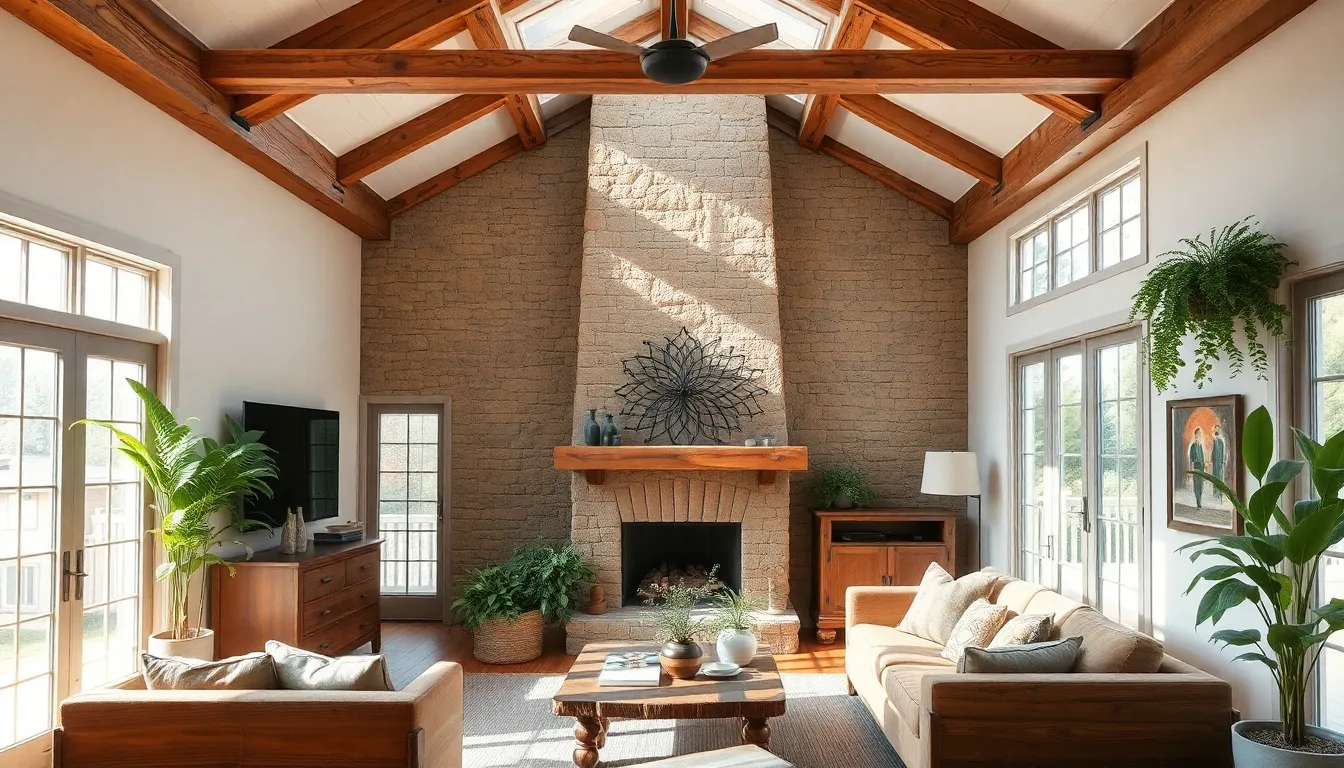Table of Contents
ToggleImagine walking into a home that feels like a warm hug from nature itself. Rustic home decor brings that cozy vibe right to the heart of any living space. It’s all about embracing the charm of the countryside with weathered wood, earthy tones, and a sprinkle of vintage flair. Who wouldn’t want their home to feel like a charming cabin in the woods?
But rustic decor isn’t just for log cabins or country cottages. It’s versatile enough to fit into modern spaces, adding character and warmth. Think reclaimed wood accents, handmade pottery, and textiles that tell a story. With rustic decor, you can transform your home into a sanctuary that feels both stylish and inviting. So why not trade those sterile, cookie-cutter designs for something that truly reflects personality? Dive into the world of rustic decor and let your home tell its own unique tale.
Understanding Rustic Home Decor
Rustic home decor embodies a warm, inviting atmosphere that often evokes the charm of countryside living. This style effectively utilizes natural materials and traditional elements to establish a cozy sanctuary.
What Is Rustic Home Decor?
Rustic home decor incorporates design elements that emphasize natural beauty and simplicity. It often includes items such as reclaimed wood furniture, stone accents, and handcrafted details. Rustic design connects to a lifestyle that appreciates imperfections and the authenticity of nature. This approach allows the integration of vintage and antique pieces, which contribute to its overall warmth and character.
Key Characteristics of Rustic Style
Distinct characteristics define rustic style. First, natural materials, like wood and stone, take center stage. Second, earthy color palettes, featuring browns, greens, and soft neutrals, create a harmonious environment. Third, texture plays a significant role, incorporating woven fabrics, natural fibers, and metal accents. Fourth, vintage items often serve as focal points, fostering a sense of history and personal touch. Lastly, simplicity prevails through functional designs that complement rather than overpower a space. Each element contributes to the unique, cozy ambiance that rustic decor delivers.
History of Rustic Home Decor

Rustic home decor traces its roots back to the countryside, embracing simplicity and natural materials. This style reflects a connection to nature, often featuring raw elements.
Origins and Evolution
Rustic decor originated from rural settings where functional items served practical purposes. Early settlers used local materials, like wood and stone, to create functional spaces. Over time, these traditional practices evolved into a distinct design aesthetic. The 20th century saw a resurgence in interest, with influences from the Arts and Crafts Movement. This movement focused on handmade craftsmanship and sustainability. By the late 20th century, rustic decor gained popularity in urban environments, as people sought comfort in nature-inspired settings. Reclaimed materials became a hallmark of modern rustic design, blending past traditions with contemporary needs.
Influences on Modern Design
Modern rustic decor draws from various influences, including Scandinavian minimalism and industrial aesthetics. Natural textures contribute to a warm ambiance, merging functionality with style. Design elements like exposed beams and reclaimed wood add character to contemporary spaces. Additionally, a growing emphasis on eco-friendly practices impacts modern rustic trends. Brands and designers prioritize sustainability, encouraging the use of recycled and locally sourced materials. Artisans and craftsmen also play a significant role, creating unique pieces that reflect traditional techniques. Ultimately, rustic decor continues to evolve, integrating diverse influences while maintaining its core charm.
Elements of Rustic Home Decor
Rustic home decor features various elements that create a warm and inviting environment. These components embody natural beauty and craftsmanship.
Natural Materials
Natural materials form the backbone of rustic home decor. Wood dominates, with reclaimed timber providing unique character and warmth. Stone elements often accentuate spaces, bringing an organic feel indoors. Fabrics like linen and cotton enhance textures, creating comfortable, lived-in vibes. Handmade items, crafted from pottery or metal, highlight artisanal skill while emphasizing sustainability. Nature-inspired decor echoes a connection to the outdoors, fostering a serene atmosphere.
Color Palettes
Color palettes play a crucial role in conveying rustic charm. Earthy tones such as browns, greens, and muted grays establish a foundation that calms the senses. Adding splashes of warm colors, like terracotta and golden yellows, brings life without overwhelming the space. Soft neutrals complement darker shades, enhancing brightness and creating balance. Natural lighting often interacts beautifully with these hues, enhancing the overall appeal while promoting a cozy, inviting environment.
Furniture and Accessories
Furniture choices significantly impact the rustic aesthetic. Vintage items, such as weathered tables and distressed chairs, add charm and character. Combining functional pieces with artisanal craftsmanship fosters a unique style. Cozy textiles, including handmade quilts or knitted throws, provide comfort alongside visual appeal. Accessories like wrought iron fixtures or wooden sculptures serve as focal points, enriching the space’s charm. Integrating these elements creates an inviting atmosphere resonating with rustic authenticity.
Tips for Achieving Rustic Home Decor
Achieving rustic home decor involves thoughtful layering of elements that create warmth and charm. Prioritize natural materials and textures for an inviting atmosphere.
Incorporating Textures
Textures play a crucial role in rustic decor. Incorporate various materials like wood, stone, metal, and textiles to add depth. Use reclaimed wood for furniture and flooring to maintain authenticity. Stone accents, such as a fireplace or wall, enhance the rustic vibe. Fabrics like burlap, linen, and cotton contribute softness and comfort. Mixing rugs with different weaves or patterns elevates the interaction of various textures throughout the space.
DIY Projects
DIY projects offer a unique opportunity to personalize rustic decor. Consider creating furniture from reclaimed wood or repurposing vintage items. Crafting decorative pieces, such as wooden signs or candle holders, adds a personal touch. Hands-on projects reinforce the rustic aesthetic and often yield one-of-a-kind pieces. Following step-by-step guides available online helps simplify the process. Opting for these projects encourages creativity and self-expression in home design.
Mixing Rustic with Other Styles
Combining rustic decor with other styles creates a distinctive look. Blend rustic elements with modern minimalism for contrast. Industrial accents, like metal fixtures, add a contemporary edge. Incorporate Scandinavian design principles, focusing on simplicity and functionality. This fusion enhances visual interest and maintains a cozy environment. Layering rustic charm with farmhouse or vintage styles broadens design possibilities, allowing for unique, personalized spaces.
Rustic home decor offers a unique blend of warmth and charm that can transform any space into a cozy retreat. By embracing natural materials and vintage accents, individuals can create an inviting atmosphere that reflects their personal style. The versatility of rustic decor allows it to seamlessly integrate into various design aesthetics, enhancing both traditional and modern homes.
With a focus on authenticity and craftsmanship, rustic decor encourages creativity through DIY projects and layering of textures. This style not only fosters a sense of comfort but also connects individuals to the beauty of nature. As trends continue to evolve, rustic decor remains a timeless choice for those seeking to create a warm and welcoming sanctuary.




